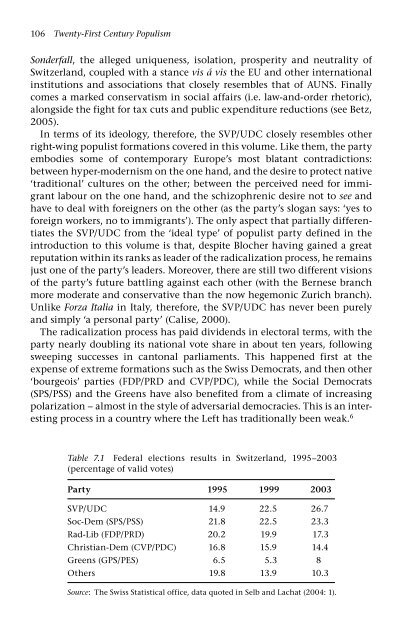Twenty-First Century Populism: The Spectre of Western European ...
Twenty-First Century Populism: The Spectre of Western European ...
Twenty-First Century Populism: The Spectre of Western European ...
Create successful ePaper yourself
Turn your PDF publications into a flip-book with our unique Google optimized e-Paper software.
106 <strong>Twenty</strong>-<strong>First</strong> <strong>Century</strong> <strong>Populism</strong><br />
Sonderfall, the alleged uniqueness, isolation, prosperity and neutrality <strong>of</strong><br />
Switzerland, coupled with a stance vis á vis the EU and other international<br />
institutions and associations that closely resembles that <strong>of</strong> AUNS. Finally<br />
comes a marked conservatism in social affairs (i.e. law-and-order rhetoric),<br />
alongside the fight for tax cuts and public expenditure reductions (see Betz,<br />
2005).<br />
In terms <strong>of</strong> its ideology, therefore, the SVP/UDC closely resembles other<br />
right-wing populist formations covered in this volume. Like them, the party<br />
embodies some <strong>of</strong> contemporary Europe’s most blatant contradictions:<br />
between hyper-modernism on the one hand, and the desire to protect native<br />
‘traditional’ cultures on the other; between the perceived need for immigrant<br />
labour on the one hand, and the schizophrenic desire not to see and<br />
have to deal with foreigners on the other (as the party’s slogan says: ‘yes to<br />
foreign workers, no to immigrants’). <strong>The</strong> only aspect that partially differentiates<br />
the SVP/UDC from the ‘ideal type’ <strong>of</strong> populist party defined in the<br />
introduction to this volume is that, despite Blocher having gained a great<br />
reputation within its ranks as leader <strong>of</strong> the radicalization process, he remains<br />
just one <strong>of</strong> the party’s leaders. Moreover, there are still two different visions<br />
<strong>of</strong> the party’s future battling against each other (with the Bernese branch<br />
more moderate and conservative than the now hegemonic Zurich branch).<br />
Unlike Forza Italia in Italy, therefore, the SVP/UDC has never been purely<br />
and simply ‘a personal party’ (Calise, 2000).<br />
<strong>The</strong> radicalization process has paid dividends in electoral terms, with the<br />
party nearly doubling its national vote share in about ten years, following<br />
sweeping successes in cantonal parliaments. This happened first at the<br />
expense <strong>of</strong> extreme formations such as the Swiss Democrats, and then other<br />
‘bourgeois’ parties (FDP/PRD and CVP/PDC), while the Social Democrats<br />
(SPS/PSS) and the Greens have also benefited from a climate <strong>of</strong> increasing<br />
polarization − almost in the style <strong>of</strong> adversarial democracies. This is an interesting<br />
process in a country where the Left has traditionally been weak. 6<br />
Table 7.1 Federal elections results in Switzerland, 1995–2003<br />
(percentage <strong>of</strong> valid votes)<br />
Party 1995 1999 2003<br />
SVP/UDC 14.9 22.5 26.7<br />
Soc-Dem (SPS/PSS) 21.8 22.5 23.3<br />
Rad-Lib (FDP/PRD) 20.2 19.9 17.3<br />
Christian-Dem (CVP/PDC) 16.8 15.9 14.4<br />
Greens (GPS/PES) 6.5 5.3 8<br />
Others 19.8 13.9 10.3<br />
Source: <strong>The</strong> Swiss Statistical <strong>of</strong>fice, data quoted in Selb and Lachat (2004: 1).



